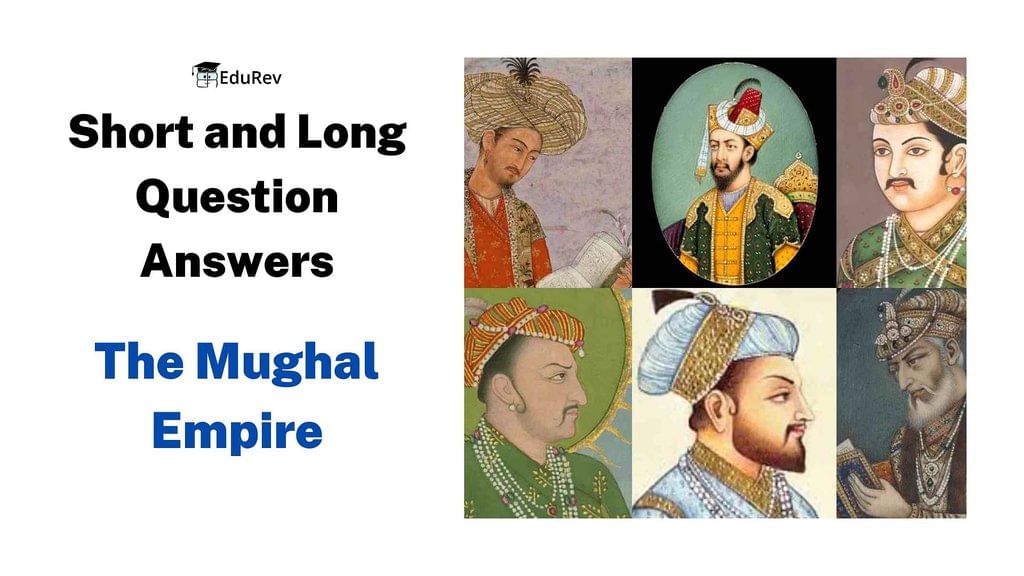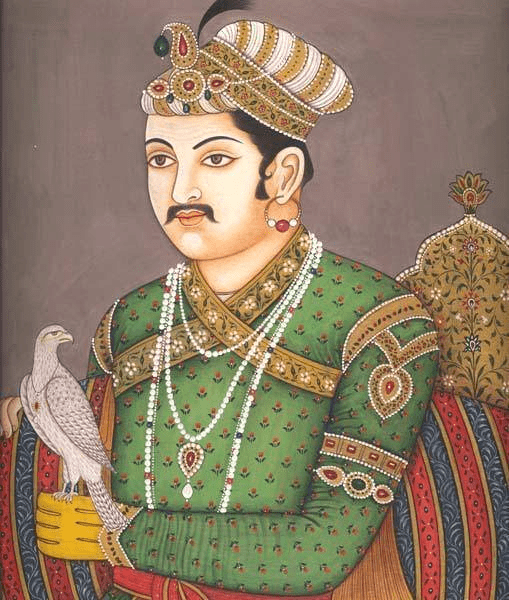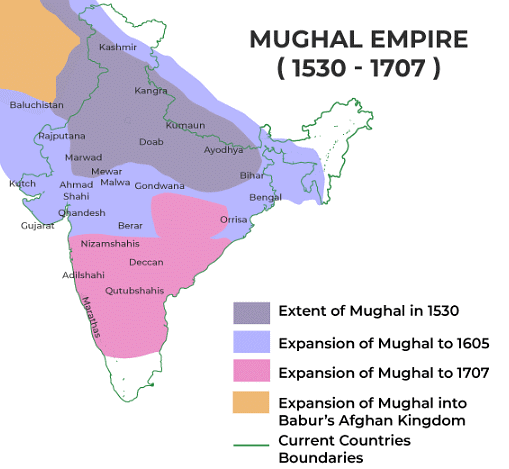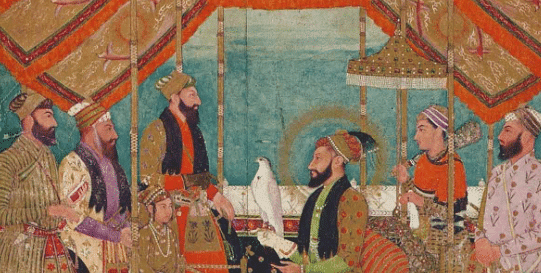Class 7 History Chapter 4 Question Answers - The Mughal Empire

Short Answer Type Questions
Q1. Write short notes on Akbar's religious policy.Ans. Akbar's liberal religious views and his marriage to the Rajput princess influenced his religious outlook. He used to hold talks with the leaders of various religions.
- He also built a building called Ibadat Khana at Agra to hold discussions with the religious leaders. Views were exchanged freely.
- He also introduced the policy of sulh-i-kul. This idea of tolerance focused on honesty, justice, and peace that were universally applicable. Akbar found that all religions taught similar ideologies.
- Thus he incorporated the principles of all the religions to found a new faith which he named Din-i-Illahi.
 AkbarQ2. What was Mansab System?
AkbarQ2. What was Mansab System?
Ans. Mansab system was a grading system used by the Mughal rulers to fix the rank or salary of a Mansabdar, who were basically their military commanders
Q3. What important measures were taken by Akbar to consolidate his empire?
Ans. Akbar strengthened the Muslim empire by expanding it and conquering many other cities. He took control of most of India and killed various other leaders. He was also very tolerant towards other religions and married a Hindu princess so that the Rajputs (very brave soldiers) would not threaten him.
Q4. What were the military responsibilities of Mansabdars?
Ans. The military responsibilities of mansabdars were:
- The Mansabdar was required to maintain a specified number of cavalrymen
- The Mansabdar had to bring his cavalrymen for review, get them registered, and get their horses branded
Q5. Give a brief account of the conquests of Akbar.
Ans. When Akbar was crowned in 1556 A.D. the Mughal Empire was scattered. He established a vast kingdom by conquering other kingdoms.
- He captured Gwalior, Ajmer, Jaunpur, and Malwa. He also succeeded in capturing the famous forts of Ranthambhor and Chittor.
- Military campaigns in Gujarat were followed by campaigns in the east in Bihar, Bengal, and Orissa. Akbar's armies also conquered Kabul, Sind, and Baluchistan.
- From 1595 to 1601 the Mughal forces remained busy in the annexation of Berar, Khandesh, and parts of Ahmadnagar.
Q6. Describe the Rajput policy of Akbar.
Ans.
- Akbar gave complete religious freedom to his Hindu wives and gave an honored place to their parents and relations in the nobility and he gave high posts to Rajputs in his empire.
- Most Rajput kings recognized Akbar's supremacy and later on helped Akbar in expanding and consolidating the Mughal empire.
Q7. Who was the first Mughal emperor and which territories did he conquer during his reign?
Ans. The first Mughal emperor was Babur who seized Kabul in 1504 and later defeated the Sultan of Delhi, Ibrahim Lodi, at Panipat in 1526, capturing Delhi and Agra.
Q8. What were the reasons for Babur's success in the First Battle of Panipat?
Ans. Following are the reasons for the success of Babur in the first battle of Panipat were:
- Strong artillery which was a new introduction to the Indian army and a well-trained cavalry
- Good generalship, Babur arranged his soldiers in such a way that they could move easily from one part of the battle to another.
 First Battle of Panipat
First Battle of Panipat
Q9. Who was Akbar's revenue minister, and what did he do?
Ans. Akbar's revenue minister was Todar Mal, who carried out a careful survey of crop yields, prices, and areas cultivated for a 10-year period from 1570-1580.
Q10. Name the mothers of Jahangir and Shah Jahan.
Ans. The mother of Jahangir was a Kachhwaha princess, the daughter of the Rajput ruler of Amber. The mother of Shahjahan was a Rathor princess, the daughter of the Rajput ruler of Marwar.
Q11. Explain the Mughal relations with other rulers.
Ans. Mughal rulers campaigned constantly against rulers who refused to accept their authority. But as the Mughals became powerful, many other rulers joined them voluntarily. The Rajputs were a good example. Many of them married their daughters into Mughal families and received high positions. But many resisted as well.
Q12. What was Zabt and who were Zamindars?
Ans.
- Land revenue was the main source of income for the Mughal rulers. Revenue on each crop was fixed in cash. Each province was divided into revenue circles, with its own schedule of revenue rates for individual crops. This revenue system was known as 'zabt'.
- In most places, the headman or the local chieftain collected revenue from these peasants and deposited it in the royal treasury. The Mughals called these intermediaries, whether they were local headmen of villages or powerful chieftains, zamindars.
 Zamindari SystemQ13. Who were Mansabdars?
Zamindari SystemQ13. Who were Mansabdars?
Ans.
- The term mansabdar refers to an individual who holds a mansab, meaning a position or rank.
- It was a grading system used by the Mughals to fix rank, salary and military responsibilities.
- Rank and salary were determined by a numerical value called zat.
- The higher the zat, the more prestigious the noble’s position in court and the larger his salary.
Q14. What is the Ain-i Akbari and what does it provide information about?
Ans.
- The Ain-i Akbari is the third volume of the Akbar Nama, a history of Akbar's reign written by Abul Fazl.
- It provides information about Akbar's administration, household, army, revenues, and the geography of his empire.
- Additionally, it includes rich details about the traditions, culture, crops, yields, prices, wages, and revenues of the people living in India during that time.
Q15. Who was Jahangir?
Ans.
 Mughal Emperor- Jahangir
Mughal Emperor- Jahangir
- Jahangir was the fourth ruler of the Mughal dynasty in India, he was born on 31 August 1569, his birth name was Nur ud din, Muhammad Salim.
- He was born on 31st August 1569 in Fatehpur Sikri with a name as Nur-ud-din Muhammad Salim.
- Akbar ensured that his son should get a good education from the best tutors. Salim started his learning at the age of 5.
- He grew impatient and revolted against his own father in 1599 but was unsuccessful. It is said that after this, the relationship between Akbar and Jahangir became strained.
Q16. Who was Babur?
Ans.
- Babur, the first Mughal emperor (1526 –1530), succeeded to the throne of Ferghana in 1494 when he was only 12 years old.
- He was forced to leave his ancestral throne due to the invasion of another Mongol group, the Uzbegs. After years of wandering, he seized Kabul in 1504.
- In 1526 he defeated the Sultan of Delhi, Ibrahim Lodi, at Panipat and captured Delhi and Agra.
 Babur , First Mughal Emperor
Babur , First Mughal Emperor
Long Answer Type Questions
Q1. What were the significant developments, achievements, and challenges faced by the Mughal Empire during the seventeenth century, and what was its lasting impact on the Indian subcontinent in the years that followed?Ans. During the seventeenth century, the Mughal Empire was at its zenith in terms of territorial expansion, architectural achievements, cultural developments, and economic prosperity. The empire witnessed the reigns of some of the most prominent Mughal emperors, each of whom contributed to the empire's development and faced unique challenges.
1. Territorial Expansion: The Mughal Empire reached its greatest extent under Emperor Aurangzeb, who conquered several territories in the Indian subcontinent, including the Deccan Plateau, parts of southern India, and parts of modern-day Afghanistan and Pakistan. However, these conquests were marred by long-drawn-out wars, resistance from local rulers, and high military costs, leading to a decline in the empire's resources and stability.
2. Architectural Achievements: The seventeenth century witnessed some of the most iconic architectural contributions of the Mughal Empire, such as the Taj Mahal, built by Emperor Shah Jahan as a mausoleum for his wife Mumtaz Mahal. Other significant architectural marvels include the Red Fort in Delhi, the Shalimar Gardens in Lahore, and the city of Fatehpur Sikri.
3. Cultural Developments: The Mughal Empire was a melting pot of various cultures and religions, which led to significant achievements in art, literature, and music. The empire saw the fusion of Persian and Indian styles in painting, with the creation of miniature paintings depicting scenes from Mughal court life, mythology, and nature. Mughal emperors like Akbar and Shah Jahan were patrons of arts and learning, which led to the creation of several literary and historical works.
4. Economic Prosperity: The Mughal Empire experienced economic growth during this period, with the establishment of a centralized tax system and a reliable administration. Trade with Europe thrived, especially through the sea routes controlled by the Portuguese, English, and Dutch. The empire's economy relied heavily on agriculture but also saw growth in manufacturing and handicrafts.
Q2. What were the Challenges faced by the Mughal Empire during the seventeenth century:Ans:
1. Religious Conflicts: The empire faced internal religious conflicts, particularly during Aurangzeb's reign, who pursued a policy of strict Islamic standards. This led to tensions with the empire's non-Muslim subjects, particularly the Hindus and Sikhs, and contributed to the weakening of the empire's social fabric.
2. Administrative Challenges: The Mughal Empire's vast territorial expansion brought with it administrative challenges, as the empire struggled to maintain control over distant provinces. The empire's decentralized administration, which relied on local governors (subahdars) and military commanders (mansabdars), often led to corruption and inefficiency.
3. Succession Crises: The empire faced several succession crises, particularly towards the end of the seventeenth century, with the weak leadership of later Mughal emperors. This contributed to the decline of central authority and the eventual disintegration of the empire.
 Mughal Empire in the Seventeenth century
Mughal Empire in the Seventeenth century
Q3. What was the enduring effect of the Mughal Empire on the Indian Subcontinent in the subsequent years?
Ans.
1. Political Legacy: The Mughal Empire's decline in the eighteenth century led to the rise of regional powers, such as the Marathas, Sikhs, and various states in southern India. The British East India Company capitalized on these power vacuums, eventually establishing British colonial rule over the Indian subcontinent.
2. Architectural and Cultural Influence: The Mughal Empire's architectural and cultural achievements left a lasting impact on the Indian subcontinent. The fusion of Persian and Indian styles in architecture and art is still evident in various monuments and cultural expressions across India, Pakistan, and Bangladesh.
3. Religious Influence: The empire's policy of religious tolerance, particularly during Akbar's reign, contributed to the development of a unique Indo-Islamic culture that continues to influence the religious and cultural landscape of the Indian subcontinent.
4. Administrative and Economic Influence: The Mughal Empire's administrative and economic systems, such as the Mansabdari system and the centralized tax system, had a lasting impact on the Indian subcontinent's political and economic organization, with many elements continuing in various forms well into the British colonial era.
Q4. Explain the roles and importance of the Mansabdars and Jagirdars in the Mughal Empire.
Ans.
The Mansabdars and Jagirdars were crucial to the administrative and military structure of the Mughal Empire. Their roles and importance can be described as follows:
1. Mansabdars: Mansabdars were the high-ranking officials in the Mughal administration. They were appointed by the emperor and were responsible for maintaining law and order in their respective regions. They were also responsible for maintaining a certain number of troops, horses, and supplies for the Mughal army.
2. Jagirdars: Jagirdars were the landholders in the Mughal Empire, responsible for collecting taxes and ensuring the smooth functioning of agricultural activities in their respective regions. They were given land grants called jagirs by the emperor, and in return, they provided financial support and military services to the empire.
 Mansabdars and Jagirdars system
Mansabdars and Jagirdars system
3. Military Support: Both Mansabdars and Jagirdars played a crucial role in ensuring the military strength of the Mughal Empire. They were responsible for maintaining troops and horses and participated in battles and campaigns.
4. Revenue Collection: As landholders, Jagirdars were responsible for collecting taxes from the peasants and remitting them to the imperial treasury. This system ensured a steady flow of income to the royal treasury, helping the empire maintain its vast expenses.
5. Administration: Mansabdars and Jagirdars were responsible for the administration of their respective regions. They maintained law and order, ensured the welfare of the peasants, and carried out various other administrative tasks delegated by the emperor. Their efficient functioning was essential to the smooth running of the Mughal Empire.
Q5. Explain the reasons behind the Mughals emphasizing their Timurid lineage over their Mongol descent.
Ans.
The Mughals emphasized their Timurid lineage over their Mongol descent due to a combination of political, cultural, and historical factors:
1. Political Legality: The Mughals sought to establish their rule in India and claim political legitimacy by associating themselves with the prestigious Timurid dynasty. They wanted to emphasize their connection to Timur, a powerful and successful conqueror, rather than Genghis Khan, whose legacy was more controversial.
2. Cultural identity: The Mughals identified more closely with the Persian culture of the Timurids rather than the Mongol culture. They adopted Persian as the official language of their empire, and their court culture, art, and architecture were heavily influenced by Persian traditions.
3. Religious connection: The Timurids were devout Muslims, and the Mughals sought to portray themselves as Islamic rulers. This was important for establishing their rule over the predominantly Muslim population of Northern India. In contrast, Genghis Khan and the early Mongols practiced shamanism and were known for their religious tolerance, which was less appealing to the Muslim subjects of the Mughal Empire.
4. Negative Implications of Mongol rule: The Mongol Empire was known for its brutal conquests and the destruction it caused in many regions, especially in the Islamic world. Emphasizing their Mongol lineage would have associated the Mughals with this negative image, which they wanted to avoid.
5. Establishing a separate identity: The Mughals wanted to establish their own unique identity as rulers, distinct from their Mongol ancestry. By emphasizing their Timurid lineage, they could portray themselves as the inheritors of a rich cultural and political legacy, which helped them to legitimize their rule and foster a sense of pride and unity among their subjects.
|
66 videos|336 docs|46 tests
|

|
Explore Courses for Class 7 exam
|

|














